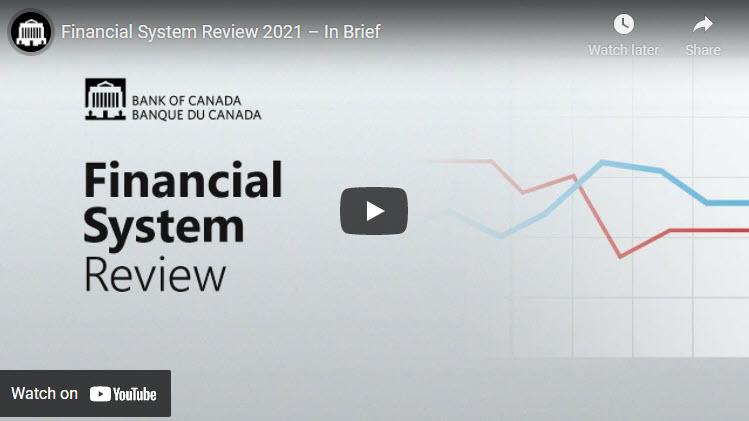
Financial system
The COVID‑19 pandemic caused a massive disruption to the Canadian economy. But the financial system proved to be resilient and acted as a shock absorber for the broader economy. Canadian banks were well capitalized going into the pandemic.
In addition, governments and the Bank provided unprecedented policy support. Consequently, commercial banks were able to continue lending to households and businesses throughout the economic downturn.
At the start of the crisis, the Bank took extraordinary measures to provide liquidity to:
- resolve the initial stress
- ensure that critical markets and the financial system continued to function well
Because these measures were successful, the Bank discontinued most of its emergency support programs by spring 2021.1

https://www.youtube.com/watch?v=cZb8lKfY7AM
Vulnerabilities and risks
The Bank’s 2021 Financial System Review presented assessments of key vulnerabilities to the financial system. Notably, it highlighted the pandemic’s impact on the financial health of Canadian households and businesses as well as some other issues of potential concern.
Throughout the year, Bank staff worked to understand vulnerabilities related to household debt and the housing market. In particular, staff used microdata to investigate the characteristics of new mortgages that are most often associated with household financial stress.2
Staff also developed innovative indicators to better understand the role that expectations and investor demand played in boosting activity and prices in the housing market during the pandemic.3 In addition, new research identified important differences in the response of housing supply to higher prices at the local level.4
In other research, Bank staff documented trends in Canada’s financial landscape, such as the rapid growth of non-bank financial intermediation.5 This development has made the financial system more vulnerable to a spike in demand for liquidity, such as the one that occurred in spring 2020.6
Climate change remained an important area of focus for the Bank in 2021, as it poses important risks to the financial system as well as to individual participants within it.
This research—and much more—was published on the Financial System Hub, the Bank’s main portal for the latest research and analysis on financial stability issues.
Our #Financial System Hub is a one-stop shop for timely work on financial stability. Check out the latest post on Canada’s housing market and household indebtedness. https://t.co/9WI0VUhTnq
— Bank of Canada (@bankofcanada) April 9, 2021

https://twitter.com/bankofcanada/status/1380525564352675840
Financial stability and monetary policy
In 2021, Bank researchers assessed potential imbalances in the housing market and considered their implications for monetary policy. Specifically, by developing and using monetary policy models with linkages to financial stability, staff studied how changes in house prices affect the overall economy.7
Further, as a continuation of 2020 work undertaken in the Bank’s Heterogeneity Laboratory (HetLab),8 staff simulated how vulnerabilities linked to household debt evolved during the pandemic for different groups and overall.9
Promoting financial system resilience
The financial system is the Canadian economy’s foundation, and the Bank works in a variety of ways to promote its efficiency and resilience.
Domestic partnerships
The Bank regularly collaborates with federal and provincial authorities to monitor and assess stress on individual commercial banks and the system as a whole.
In 2021, the Bank shared its analysis and research on the vulnerabilities stemming from housing market imbalances and elevated household indebtedness with members of the Senior Advisory Committee and the Heads of Regulatory Agencies. Subsequently, the Office of the Superintendent of Financial Institutions and the Department of Finance Canada announced the tightening of mortgage requirements.10
The Bank also:
- used insights gathered through the Systemic Risk Surveillance Committee (with both provincial and federal members) to help identify and assess vulnerabilities in the financial system11
- conducted a tabletop exercise with its partners in the Canadian Financial Sector Resiliency Group to simulate a cyber incident
The Bank and its industry partners made significant progress on developing a framework to support smooth trading and settlement of Government of Canada securities in a low interest rate environment. The proposed framework includes best practices to facilitate timely settlement, as well as a financial penalty for failing to deliver securities.
The Bank also continued to partner with Payments Canada and industry organizations to modernize Canada’s core payment systems. In August, Canada’s new large-value payment system, Lynx, was launched successfully. Lynx significantly improves the resilience of this essential component of Canada’s financial infrastructure.
Bank staff produced extensive research that helped inform this work. This included assessing:
- the factors that influence consumers’ payment choices
- how these choices could affect payment volumes in different systems12
When Lynx was launched, the Governor designated it as a systemically important payment system, moving it under the Bank’s oversight.13
“The launch of Lynx is an important step in making sure Canada’s financial system remains secure, stable and efficient in today’s rapidly evolving economy.” -BoC Governor Tiff Macklem#cdnecon #economy #payments https://t.co/cpx7qTAOLj
— Bank of Canada (@bankofcanada) September 1, 2021

https://twitter.com/bankofcanada/status/1433128277431013379
Oversight of payments and financial market infrastructures
In 2021, the Bank reached important milestones in several multi-year initiatives to strengthen payment systems and financial market infrastructures (FMIs) in Canada.
In October, the Bank released its Expectations for Cyber Resilience of Financial Market Infrastructures report. It also continued ongoing work with FMIs and the broader industry to improve their ability to recover from cyber incidents.
The Bank made significant progress on the implementation of the FMI resolution regime, notably by establishing a coordination framework for federal authorities.
Retail payments supervision
In 2021, the Bank’s tool kit for promoting the resilience of the financial system expanded. Under the Retail Payment Activities Act, the Bank will be responsible for supervising payment service providers.
Interest rate benchmark reform
In the context of ongoing international initiatives, the Bank continued to support the reform of Canadian benchmark interest rates through the Canadian Alternative Reference Rate working group (CARR), which the Bank co-chairs. As the administrator of the Canadian Overnight Repo Rate Average (CORRA), the Bank began publishing a CARR-recommended CORRA Compounded Index in April and introduced a calculator for it in December. This index and calculator are designed to make it easier for market participants to calculate interest and coupon payments for some specific securities.14
During the year, CARR also reviewed and developed recommendations for the Canadian Dollar Offered Rate (CDOR). CARR completed the first stage of its work in December 2021, when it recommended that CDOR’s administrator should cease publication of the rate after June 30, 2024, with no new CDOR exposures after June 30, 2023—except for loans and some derivative hedging activity.15 The discontinuation of CDOR will have significant implications for the Canadian financial system, including for derivatives, floating rate notes and corporate lending. CARR will continue to work with CDOR’s stakeholders to develop the tools and milestones necessary to enable a smooth transition away from CDOR to CORRA, including assessing the need for any alternative benchmarks.
Looking forward
In 2022, the Bank will continue to:
- use microdata to enrich its understanding of financial vulnerabilities and provide timely updates to Canadians of how those vulnerabilities are evolving
- incorporate financial stability considerations into monetary policy, including those arising from household heterogeneity
- work closely with domestic and international partners to share information and promote the resilience of Canada’s financial system
- evolve its oversight of prominent payment systems
- support CARR and industry stakeholders as they work to implement recommendations regarding CDOR
- finalize the framework to support smooth trading and settlement of Government of Canada securities in a low interest rate environment
More information
Regulatory Oversight of Designated Clearing and Settlement Systems
Retail Payments Advisory Committee—Brief Overview of Retail Payments Supervision
- 1. Bank of Canada, “Bank of Canada Announces the Discontinuation of Market Functioning Programs Introduced During COVID‑19” (press release, March 23, 2021).[←]
- 2. O. Bilyk, K. Chow and Y. Xu, “Can the Characteristics of New Mortgages Predict Borrowers’ Financial Stress? Insights from the 2014 Oil Price Decline,” Bank of Canada Staff Analytical Note No. 2021-22 (September 2021).[←]
- 3. U. Emenogu, C. Hommes and M. Khan, “Detecting Exuberance in House Prices Across Canadian Cities,” Bank of Canada Staff Analytical Note No. 2021-9 (May 2021).[←]
- 4. N. Paixao, “Canadian Housing Supply Elasticities,” Bank of Canada Staff Analytical Note No. 2021-21 (September 2021).[←]
- 5. R. Arora, G. Bédard-Pagé, P. Besnier, H. Ford and A. Walsh, “Non-Bank Financial Intermediation in Canada: A Pulse Check,” Bank of Canada Staff Analytical Note No. 2021-2 (March 2021).[←]
- 6. Bank of Canada, “Box 3: Looking Back at the Spring 2020 Episode of Market Liquidity Stress,” Financial System Review (May 2021).[←]
- 7. A forthcoming staff working paper will explore the role of extrapolative house price expectations in amplifying boom-bust cycles in the housing market.[←]
- 8. J. C. MacGee, T. M. Pugh and K. See, “The Heterogeneous Effects of COVID‑19 on Canadian Household Consumption, Debt and Savings,” Bank of Canada Staff Working Paper No. 2020-51 (November 2020).[←]
- 9. P. Beaudry, “Financial Stability Through the Pandemic and Beyond” (speech delivered virtually to the Ontario Securities Commission, Toronto, Ontario, November 23, 2021).[←]
- 10. Office of the Superintendent of Financial Institutions, “Amendments to the Minimum Qualifying Rate for Uninsured Mortgages” (press release, May 20, 2021); and Department of Finance Canada, “Statement by the Deputy Prime Minister and Minister of Finance on the Canadian Housing Market” (press release, May 20, 2021).[←]
- 11. Bank of Canada, “Box 5: Activities of the Heads of Regulatory Agencies and the Systemic Risk Surveillance Committee Over the Past Year,” Financial System Review (May 2021).[←]
- 12. A. Kosse, “An Empirical Analysis of Bill Payment Choices,” Bank of Canada Staff Working Paper No. 2021-23 (May 2021).[←]
- 13. Bank of Canada, “Bank of Canada Designates Lynx as a Systemically Important Payment System” (press release, September 1, 2021).[←]
- 14. Canada Mortgage and Housing Corporation announced that, starting in 2022, it will introduce pools of CORRA National Housing Act Mortgage-Backed Securities and CORRA Canada Mortgage Bonds that reference the Bank’s CORRA Compounded Index.[←]
- 15. Bank of Canada, “CARR Publishes White Paper on the Recommended Future of CDOR” (market notice, December 16, 2021).[←]